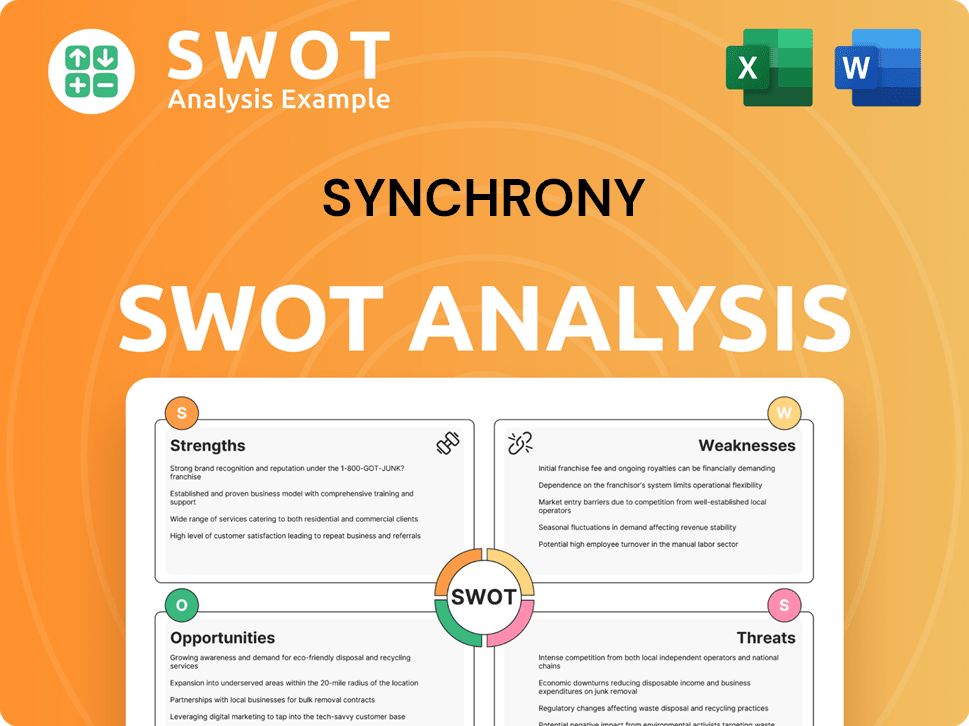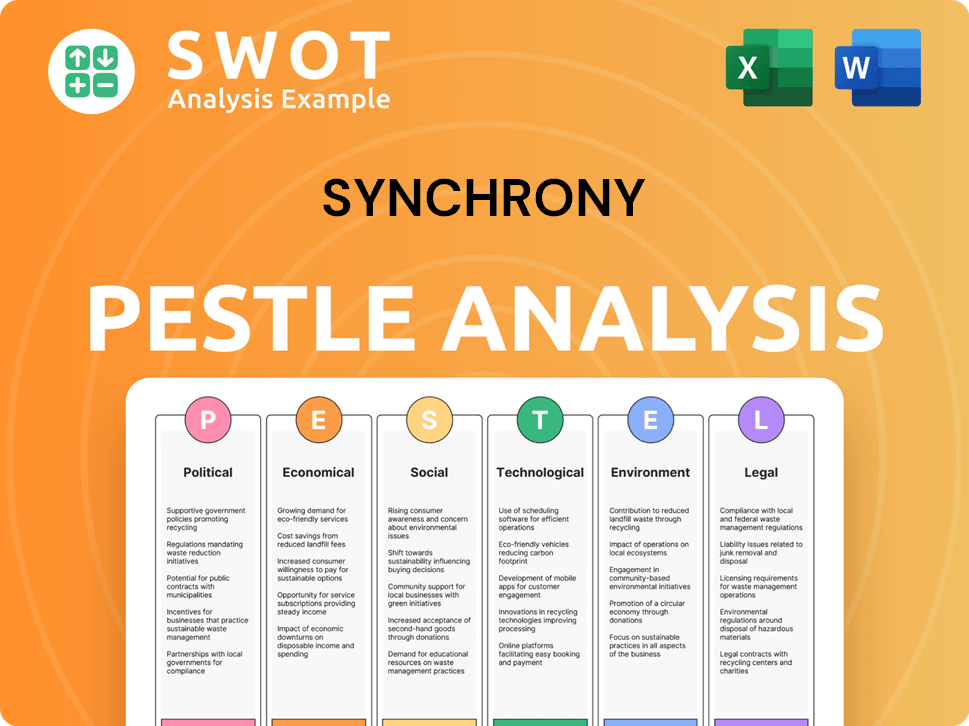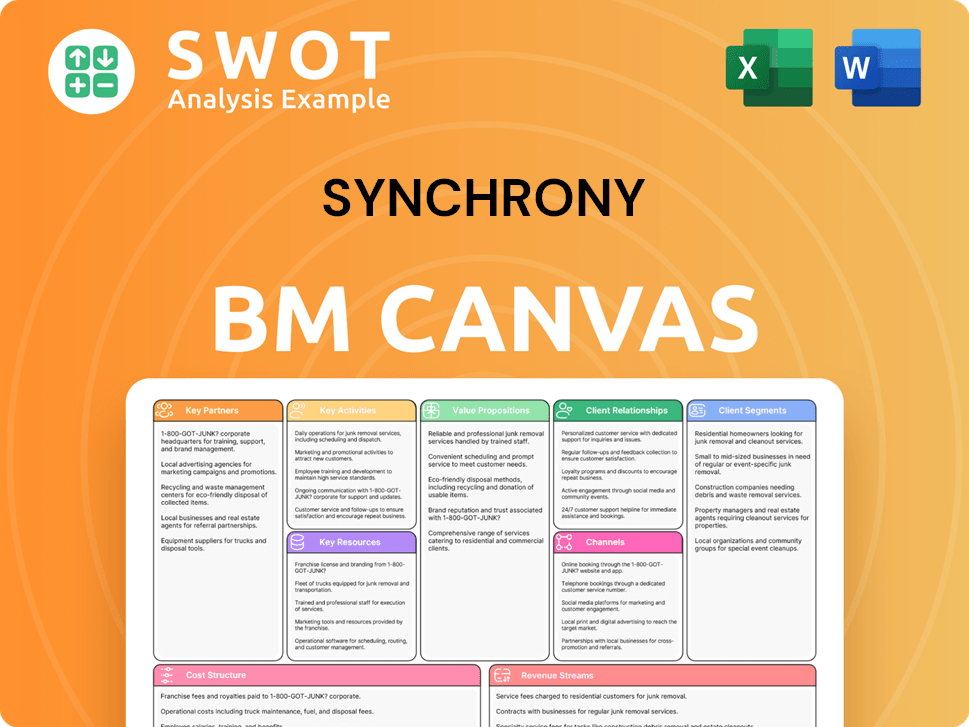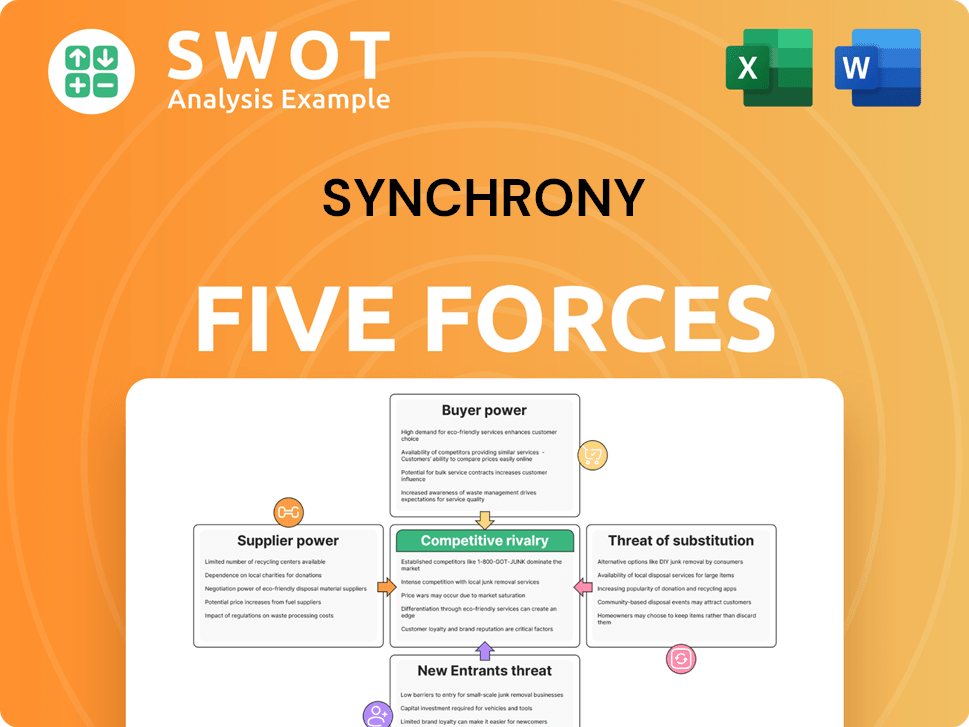Synchrony Bundle
How Does Synchrony Navigate the Fierce World of Finance?
Synchrony Financial, a titan in consumer financial services, powers transactions across the American retail landscape. From its roots as GE Capital Retail Finance, Synchrony has evolved into a publicly traded powerhouse, offering credit solutions through a vast network of partners. Its strategic partnerships and customized credit programs have solidified its position in the Synchrony SWOT Analysis and broader financial ecosystem.

This exploration dives deep into the Synchrony competitive landscape, dissecting its Synchrony Financial competitors and evaluating its Synchrony market analysis within the dynamic Synchrony industry. Understanding Synchrony's business model and its standing in the Synchrony credit card market is crucial for investors and strategists alike. We'll uncover Synchrony's main rivals in the credit card industry and compare Synchrony's market share compared to competitors, revealing Synchrony's competitive advantages and disadvantages to provide a comprehensive overview of its position.
Where Does Synchrony’ Stand in the Current Market?
Synchrony Financial holds a significant position within the consumer financial services sector, particularly in the realm of private label credit cards and promotional financing. The company's operations are centered on providing financial products to a broad customer base, including individuals and businesses. As of March 31, 2025, Synchrony reported ending loan receivables of $100 billion, showcasing the scale of its lending operations.
The company's core value proposition revolves around offering specialized financial solutions tailored to various retail partners and consumers. This includes a range of credit card products and installment loans designed to facilitate purchases and manage payments. Synchrony's business model is built on partnerships with retailers and service providers, enabling them to offer branded credit cards to their customers. This approach allows Synchrony to tap into existing customer bases and drive transaction volume.
Synchrony's strategic focus includes digital transformation and diversification. This involves expanding into healthcare financing through CareCredit and developing its own Buy Now/Pay Later (BNPL) platform. In Q1 2025, the company reported net earnings of $757 million, a return on average assets of 2.5%, and a return on tangible common equity of 22.4%. The company serves approximately 70 million customers and hundreds of thousands of partners, providers, and small and mid-sized businesses.
Synchrony's market share is substantial within the private label credit card sector. Its position is supported by extensive partnerships and a large customer base. The company competes with other major players in the Synchrony competitive landscape, including banks and financial institutions.
While operating revenue saw a 16.5% year-over-year decrease to $4.613 billion as of March 31, 2025, the company's financial health remains robust. Synchrony's allowance for bad loans stood at over 10.44% of existing receivables as of December 2024, indicating a strong balance sheet.
Synchrony's primary product lines include private label credit cards, co-branded credit cards, and installment loans. These products are tailored to meet the diverse needs of both consumers and partners. The company's focus on these products helps it maintain its position in the Synchrony industry.
The company's geographic presence is primarily within the United States, with most revenues derived from U.S. customers. This focus allows Synchrony to concentrate its efforts and resources. For further insights, see Owners & Shareholders of Synchrony.
Synchrony's competitive advantages include its strong partnerships, specialized financial products, and digital transformation initiatives. The company's ability to offer tailored solutions and adapt to market changes helps it maintain its competitive edge. Analyzing the Synchrony Financial competitors is crucial for understanding its market dynamics.
- Strong partnerships with major retailers and service providers.
- Focus on private label and co-branded credit cards.
- Strategic diversification into healthcare and BNPL.
- Robust financial performance and risk management.
Synchrony SWOT Analysis
- Complete SWOT Breakdown
- Fully Customizable
- Editable in Excel & Word
- Professional Formatting
- Investor-Ready Format

Who Are the Main Competitors Challenging Synchrony?
The Synchrony competitive landscape is shaped by a diverse group of financial institutions vying for market share in the consumer finance sector. Understanding the key players and their strategies is crucial for assessing Synchrony's market analysis and its future prospects. The company faces competition from both direct and indirect rivals, each with its own strengths and weaknesses.
Synchrony Financial competitors include traditional banks, fintech companies, and other financial service providers. These competitors challenge Synchrony through various means, including offering similar products, leveraging technological advancements, and forming strategic partnerships. The competitive dynamics are further influenced by mergers, acquisitions, and evolving consumer preferences.
Synchrony's business model and revenue streams are directly impacted by the competitive environment. The company must continuously adapt its strategies to maintain its position in the market. For more details on how Synchrony generates revenue, check out Revenue Streams & Business Model of Synchrony.
Synchrony's direct competitors include companies that offer similar financial products and services, primarily in the credit card and consumer financing space. These rivals compete head-to-head for customers and market share.
Indirect competitors include a broader range of financial institutions and fintech companies that offer alternative financing solutions or compete for consumer spending. These competitors may not directly offer credit cards but still impact Synchrony's market position.
Synchrony Financial competitors include Bread Financial Holdings, Discover Financial Services, American Express, OneMain Financial, and Fortiva Financial. These companies offer similar credit card and financing products. Other financial institutions that compete with Synchrony include Citizens Financial Group, Ally Financial, The Bank of New York Mellon, and M&T Bank Corporation.
Traditional banks like Capital One and Citibank offer a wide array of consumer banking and financial services, including credit cards. They compete with Synchrony's private label offerings by leveraging their established customer base and brand recognition.
Emerging players in the financial technology (fintech) space, particularly Buy Now/Pay Later (BNPL) providers, offer alternative financing solutions at the point of sale. These companies challenge Synchrony by providing different payment options.
Synchrony made a strategic move in March 2024 by acquiring Ally Financial Inc.'s point-of-sale financing business, Ally Lending, for $2.0 billion, enhancing its presence in the home improvement and health and wellness sectors.
The competitive dynamics in the Synchrony industry are constantly evolving. Several factors influence this landscape, including strategic partnerships, technological advancements, and changes in consumer behavior. Synchrony's ability to adapt to these changes will be crucial for its long-term success.
- Loss of Partnerships: Synchrony has faced challenges, such as the loss of significant partnerships like Walmart in 2018 and Gap in 2021, which affected its receivables.
- Mergers and Acquisitions: Mergers and acquisitions within the industry impact the competitive landscape. Synchrony's acquisition of Ally Lending is a strategic move to strengthen its market position.
- Market Share: Analyzing Synchrony's market share compared to competitors provides insight into its competitive standing.
- Digital Banking: Synchrony's digital banking initiatives and competition from fintech companies are crucial areas to watch.
Synchrony PESTLE Analysis
- Covers All 6 PESTLE Categories
- No Research Needed – Save Hours of Work
- Built by Experts, Trusted by Consultants
- Instant Download, Ready to Use
- 100% Editable, Fully Customizable

What Gives Synchrony a Competitive Edge Over Its Rivals?
Analyzing the Synchrony competitive landscape reveals a business model centered on strategic partnerships, deep lending expertise, and advanced digital capabilities. The company's strength lies in its extensive network of partners and its capacity to offer customized credit programs. In 2024, the company expanded its reach by adding over 45 new partners, including brands like Virgin Red and Gibson, and technology-focused relationships, demonstrating its commitment to diversification and market penetration.
Synchrony Financial competitors face a formidable rival in the credit card market. The company leverages its scale and data analytics to provide innovative financing solutions and seamless experiences to its approximately 70 million customers. Synchrony's focus on digital transformation and investments in data analytics has enhanced customer experience and operational efficiency, helping it to stay ahead in the Synchrony industry.
The company's financial health, with a common equity Tier 1 ratio of 13.3% at the end of December 2024, offers significant financial flexibility for investments and capital returns. These advantages have evolved to emphasize digital integration and diversification into resilient sectors like healthcare and home improvement, making its offerings more sticky and providing natural tailwinds to its mobile wallet share. To understand the company's target audience, you can read more about the Target Market of Synchrony.
Synchrony's partnership-centric approach allows it to diversify revenue streams and tap into new markets. The company added over 45 new partners in 2024, including brands like Virgin Red and Gibson, and technology-focused relationships, demonstrating its commitment to diversification and market penetration. This strategy helps in maintaining a strong position in the Synchrony credit card market.
Synchrony's focus on digital transformation and technological advancements, including investments in data analytics, has enhanced customer experience and operational efficiency. Its efforts to develop its own BNPL platform also mitigate competitive risks from emerging fintech players, ensuring it remains competitive in the Synchrony market analysis.
Synchrony's financial health, with a common equity Tier 1 ratio of 13.3% at the end of December 2024, provides significant financial flexibility for investments and capital returns. This financial strength supports the company's ability to adapt to market changes and invest in growth initiatives, ensuring its long-term competitiveness.
Synchrony serves approximately 70 million customers, focusing on delivering seamless omnichannel experiences. This customer-centric approach, supported by digital advancements and data analytics, enhances customer satisfaction and loyalty, which is crucial in the competitive landscape. This is a key element of its Synchrony business model.
Synchrony's competitive advantages include its strategic partnerships, deep lending expertise, and advanced digital capabilities. The company’s extensive network of partners allows it to offer customized credit programs. These factors contribute to its strong market position and ability to compete effectively.
- Strategic Partnerships: A robust distribution network with national and regional retailers.
- Digital Innovation: Investments in data analytics to enhance customer experience.
- Financial Strength: A common equity Tier 1 ratio of 13.3% at the end of December 2024.
- Customer Focus: Serving approximately 70 million customers with seamless experiences.
Synchrony Business Model Canvas
- Complete 9-Block Business Model Canvas
- Effortlessly Communicate Your Business Strategy
- Investor-Ready BMC Format
- 100% Editable and Customizable
- Clear and Structured Layout

What Industry Trends Are Reshaping Synchrony’s Competitive Landscape?
The financial services industry is currently undergoing significant transformations driven by technological advancements, evolving consumer preferences, and regulatory changes. These factors are creating both challenges and opportunities for companies like Synchrony Financial. The increasing shift towards digital solutions and value-driven products is reshaping how financial institutions engage with their customers, prompting Synchrony to invest heavily in digital capabilities and expand its mobile wallet penetration, as highlighted in a historical overview of Synchrony.
Synchrony's competitive landscape is influenced by its ability to adapt to these changes. The company faces challenges such as the deceleration in loan growth, with a 2.1% year-over-year decline as of May 2025, and modest revenue growth of 0.44% over the last twelve months. Furthermore, new regulations, like the CFPB's rule on late fees, could impact revenue. However, Synchrony's strategic adjustments and focus on resilient sectors position it for future growth.
The financial services sector is experiencing a surge in digital transformation, with a growing preference for mobile banking and online financial management tools. Consumers are increasingly seeking personalized financial experiences, leading to a rise in demand for tailored products and services. Regulatory changes, such as those impacting late fees, are also reshaping the industry landscape.
Decelerating loan growth and potential impacts from new regulations pose significant challenges. Maintaining credit quality and managing net charge-offs are critical. Stiff competition from both traditional banks and fintech companies requires continuous innovation in product offerings and customer service.
Strategic adjustments and investments in emerging markets offer growth potential. Expanding partnerships and leveraging AI for enhanced security and personalization can drive customer loyalty. Focusing on sectors like home, auto, and healthcare, along with BNPL platforms, provides avenues for long-term value creation.
Synchrony's acquisition of Ally Lending in March 2024 is aimed at expanding its footprint in home improvement and health and wellness. The company is focusing on diversifying markets and distribution channels, adding new partners and expanding the utility of its products to drive greater lifetime value. The company projects low single-digit growth in loan receivables for 2025.
Synchrony's competitive strengths include its strong capital position and its strategic partnerships in resilient sectors. It has a well-established BNPL platform, which enhances its market position. The company's ability to leverage AI for enhanced security and personalization is another key advantage.
- Strong capital position
- Strategic partnerships in home, auto, and healthcare
- Established BNPL platform
- Leveraging AI for enhanced security and personalization
Synchrony Porter's Five Forces Analysis
- Covers All 5 Competitive Forces in Detail
- Structured for Consultants, Students, and Founders
- 100% Editable in Microsoft Word & Excel
- Instant Digital Download – Use Immediately
- Compatible with Mac & PC – Fully Unlocked

Related Blogs
- What are Mission Vision & Core Values of Synchrony Company?
- What is Growth Strategy and Future Prospects of Synchrony Company?
- How Does Synchrony Company Work?
- What is Sales and Marketing Strategy of Synchrony Company?
- What is Brief History of Synchrony Company?
- Who Owns Synchrony Company?
- What is Customer Demographics and Target Market of Synchrony Company?
Disclaimer
All information, articles, and product details provided on this website are for general informational and educational purposes only. We do not claim any ownership over, nor do we intend to infringe upon, any trademarks, copyrights, logos, brand names, or other intellectual property mentioned or depicted on this site. Such intellectual property remains the property of its respective owners, and any references here are made solely for identification or informational purposes, without implying any affiliation, endorsement, or partnership.
We make no representations or warranties, express or implied, regarding the accuracy, completeness, or suitability of any content or products presented. Nothing on this website should be construed as legal, tax, investment, financial, medical, or other professional advice. In addition, no part of this site—including articles or product references—constitutes a solicitation, recommendation, endorsement, advertisement, or offer to buy or sell any securities, franchises, or other financial instruments, particularly in jurisdictions where such activity would be unlawful.
All content is of a general nature and may not address the specific circumstances of any individual or entity. It is not a substitute for professional advice or services. Any actions you take based on the information provided here are strictly at your own risk. You accept full responsibility for any decisions or outcomes arising from your use of this website and agree to release us from any liability in connection with your use of, or reliance upon, the content or products found herein.